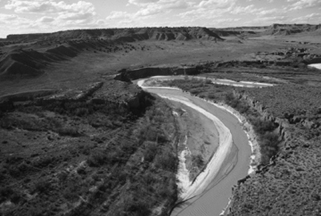|
The Rio Puerco is a sediment choked ephemeral river that drains much of northern New Mexico. The river, fed sediment by collapsing banks and numerous deep gullies (termed arroyos), has been studied extensively by the USGS and others because of the damage erosion and sedimentation have caused both locally (where deep incision leaves wells high and dry and disrupts transportation) and far away where sediment pours into the Rio Grande.
We used 10-Be to estimate geologic rates of sediment generation for comparison to modern rates of landscape change. Doing analyses of both a small basin and the entire drainage network, we find that the rate of sediment generation over long time scales is steady and varies with a variety of metrics describing vegetation, precipitation, and rock erodibility. Here, basin slope does not appear to influence erosion. Modern rates of sediment export appear to exceed long term rates by a factor of two or more, suggesting that the current wave of incision is a transient feature and that sediment yields change over time complicating land management decisions.
This research has been supported by the USGS.
Relevant Publications:
- Gellis, A., Pavich, M., Bierman, P.R., Clapp, E., Ellwein, A., Aby, S. (2004) Modern sediment yield compared to geologic rates of sediment generation in a semi-arid basin, New Mexico – determining the human impact. Earth Surface Processes and Landforms. Volume 29, Issue 11 , Pages 1359 - 1372
- Bierman, P. R., Reuter, J. M., Pavich, M., Gellis, A. Caffee, M. W. and Larsen, J., (2005) Using cosmogenic nuclides to contrast rates and scales of sediment production and sediment yield in the semi-arid, arroyo-dominated landscape of the Rio Puerco Basin, New Mexico. Earth Surface Processes and Landforms. 30(8): 935
- Clapp, E., Bierman, P.R., Pavich, M., and Caffee, M. (2001) Rates of sediment supply to arroyos from uplands determined using in situ produced cosmogenic 10Be and 26Al in sediments. Quaternary Research. v. 55, n. 2. P. 235-245.
|




